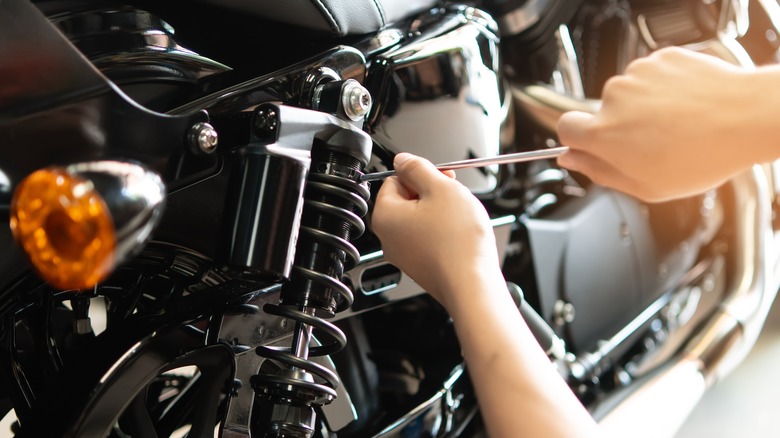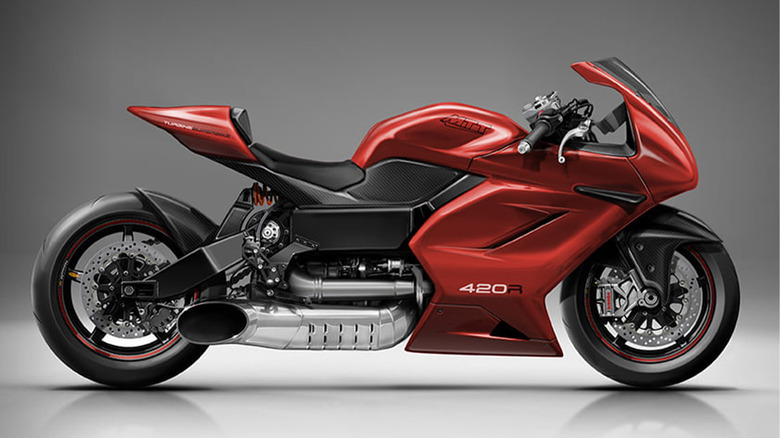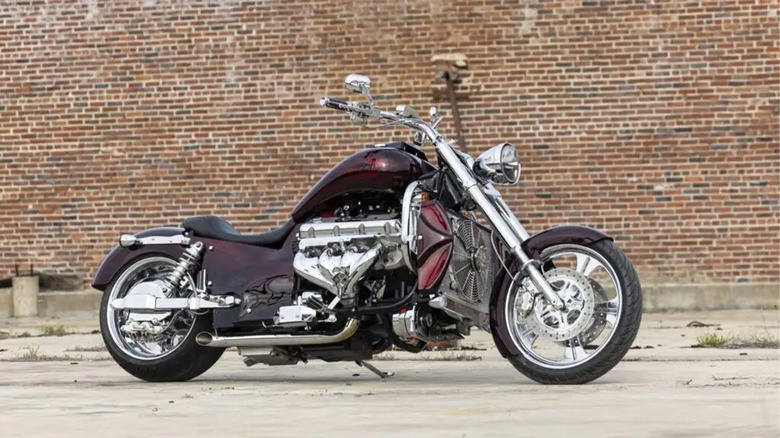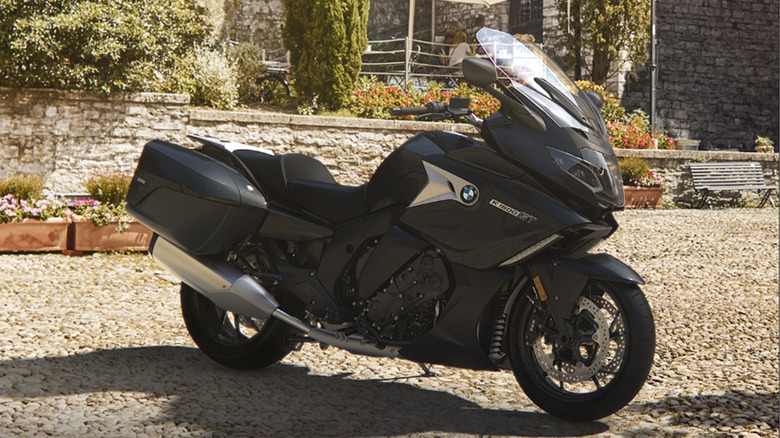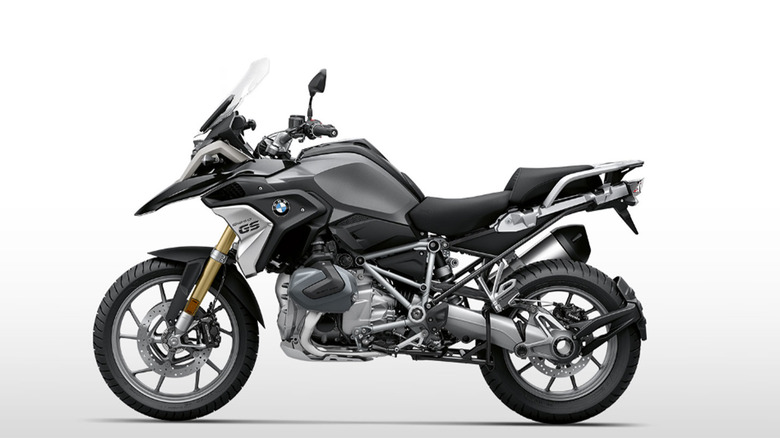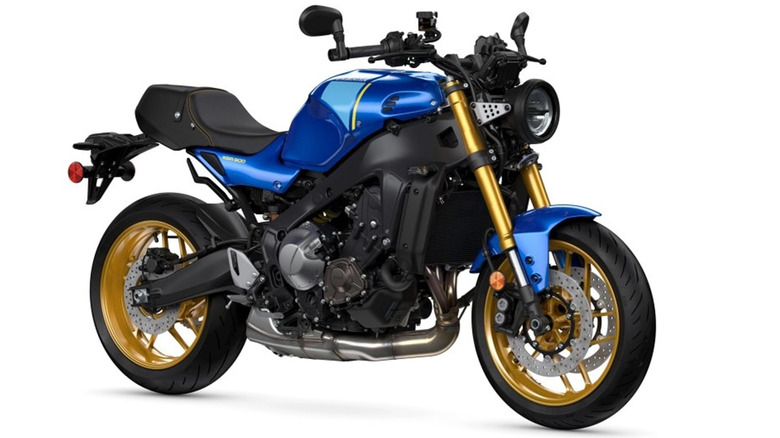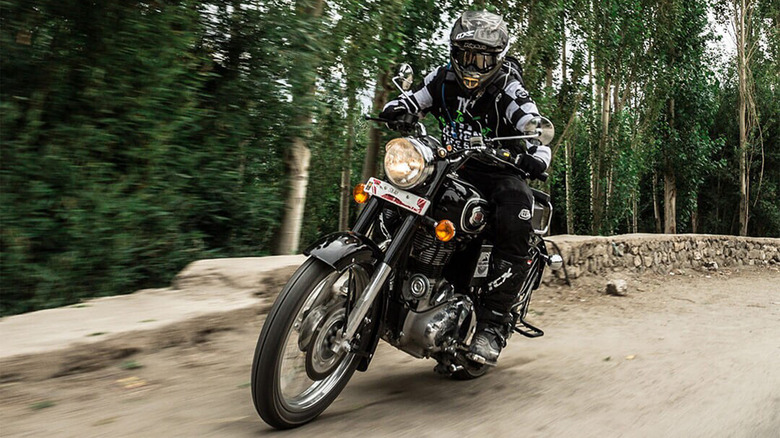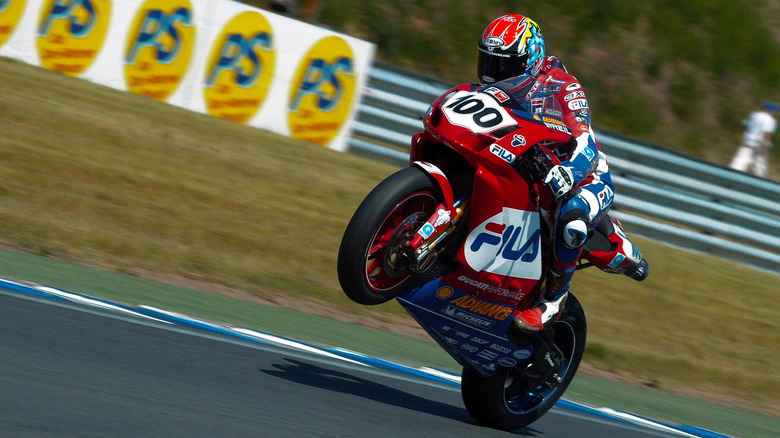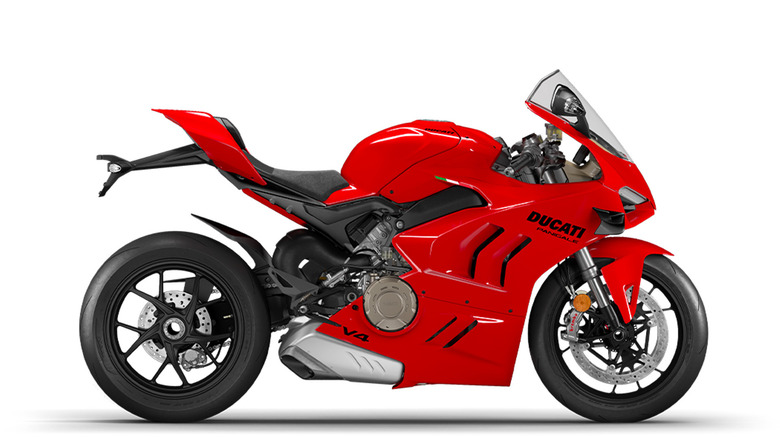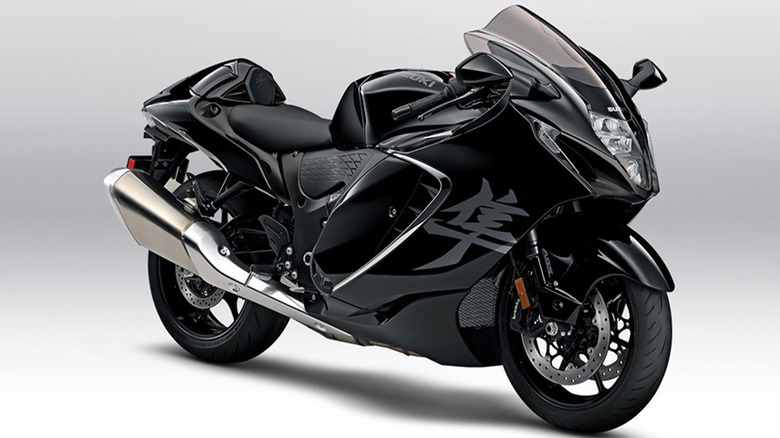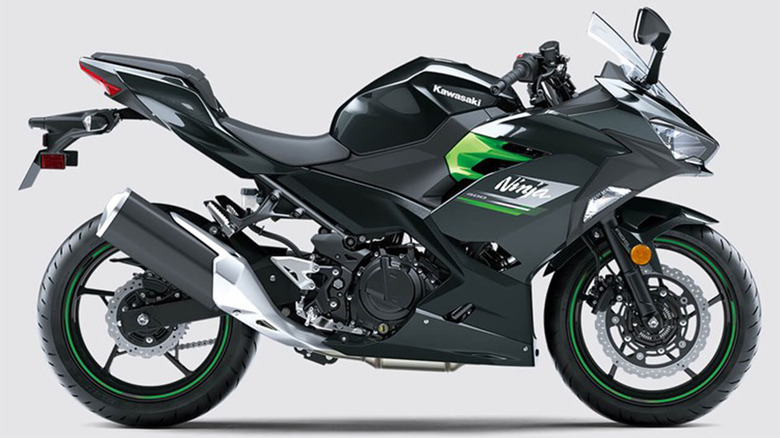Every Major Motorcycle Engine Type Ranked From Worst To Best
Motorcycles come in many shapes and sizes. There are retro-inspired café racers, adventure motorcycle-style scramblers, and speed-oriented sport bikes. They have gotten both smaller and bigger with a variety of designs to cater to a bunch of different lifestyles. You may be familiar with the small bikes that zip around crowded metropolitan areas around the world and cruisers that you can hear coming on the highway a mile away. With so many variations, it's hard to keep track — especially since those new designs have come with several different engine configurations.
When it comes to motorcycle engines, a lot of it comes down to personal taste. Some folks like the smooth high-speed of larger engines, while others prefer the smaller, more agile engines for use in deliveries and weaving through city traffic. As such, a list like this has a large degree of preference to it. However, based on what we've seen, we think we can get a reasonably accurate ranking of every motorcycle engine used today.
In general, we weighed not only the power and balance of the engine but also its popularity and use cases. Most motorcycles are used in crowded cities worldwide, so we put a bit of extra weight on motorcycles that are adept at that kind of behavior. So, technically, yes, the V4 is a more capable engine than a parallel twin, but parallel twins are much better in the city than a V4, so we think the parallel twin is better for most types of motorcycle shoppers. Let the games begin.
10. Alternative and rare engine types
There are a lot of motorcycle engines out there and not all of them are popular enough for a list like this. So, we thought we'd take a minute to highlight some of the rarer and more unique examples of engines that you probably can't get. For example, there are only a handful of five-cylinder motorcycles, and most aren't for sale anymore. Honda did make a five-cylinder engine, but it was used almost exclusively for racing. So, while these engines exist, you can't really get your hands on them without a lot of effort.
However, what we really wanted to highlight here is the unique fuel turbine engine of the MTT Streetfighter, one of the fastest motorcycles in the world. You wouldn't know it just from looking, but the powerplant in that thing is something special. You can technically buy an MTT Streetfighter, although they reportedly cost well north of $150,000, depending on the year and who you ask. It sounds like a jet engine because it's essentially powered by one. Only serious collectors should even consider trying to find one.
There are also EV motorcycles available. Zero Motorcycles sells some, as do a few competitors. Some are highway capable and get decent range for how small the battery packs are, while others are scooter types for getting around town. However, this is an emerging technology that is almost certainly going to improve over the next decade or so. EV engines aren't bad, but they're still not quite there yet.
9. V8
It's incredible to think that V8 motorcycles exist in the wild and that you can actually buy one. There are very few examples of this, but perhaps none more notable than the Boss Hoss. These come with slightly modified versions of the same V8 engine that comes in a Chevy Corvette. Nope, that's not a typo, nor is it a joke. These things have sports car engines in them, and it's hilarious. However, there are plenty of other examples of V8 engines in motorcycles, such as the ancient Curtiss V8 or the Lazareth LM 847. They are all massive.
So, why is this monstrosity at the bottom of the list? For obvious reasons. There are only a handful of examples, so it's highly unlikely that most riders will ever run into a bike like this. The engine isn't the hardest to work on, but it consumes fuel like crazy. They are also huge, unwieldy, loud, and heavy. Bikes made with V8 engines are not for weaving in and out of traffic — they're made to go mostly in a straight line. That puts a hard limit on the type of buyer who would want something like this.
On the plus side, when made correctly, V8 motorcycles are super fun. Reports are that the Boss Hoss, at least, rides surprisingly well for its massive size. There's usually plenty of power across the torque range and it'll get you to highway speeds as quickly as any V8 can.
8. Inline six
Inline six cylinder engines aren't the most common type out there, but they are available on modern bikes. Perhaps the most successful example is the BMW K 1600 GT, which comes in at a whopping $24,295 MSRP before fees. Inline six bikes are almost all expensive like that since their engines are so beefy. It's easy to see why such an engine is good. The 1600 GT's top speed is 141 mph, which it can hit without drama.
What makes inline six engines less desirable is the fact that they're complicated. Unlike some other engine types further down the list, inline six engines are heavy, complex machines that aren't the easiest to work on for the home mechanic. They also tend to guzzle more fuel than their smaller counterparts. In short, they are not the easiest bikes to ride, maintain, or pay for. That puts them pretty far down the list.
That isn't to say that they're bad engines, though. If you can handle one, they're super fun. They can go fast, perform well, and they're exceptionally well-balanced. They're mostly just not something we'd recommend to beginner or even intermediate riders. This is an endgame engine for experienced bike owners and mechanics.
7. Flat twin (boxer twin)
The flat twin, also known as the boxer twin, is a two-cylinder engine style mostly used by BMW. It's honestly only this far down the list because it's not commonly used, as it's otherwise a nice engine type. Flat twin engines get their name because the cylinders are flat instead of vertical like you find in inline or V-style engines.
There are some benefits to a boxer engine. They are flat and a little heavy, which brings down the center of gravity on motorcycles. That makes it feel lighter and more maneuverable to the rider, which is nice. They are also reasonably well-balanced, decently easy to work on, and also fairly reliable. Air-cooled boxer engines have been around since the 1920s because they are reliable, easy to use, and cheap to repair.
Unfortunately, modern times are different from the good old days. BMW is one of the few purveyors of the boxer twin in modern times with their R-series of motorcycles. They are quite nice, even if they are fairly expensive. The 2024 model costs $20,095 brand new, which puts it in the same price range as a budget car. This would almost certainly be higher on the list if there was more availability for it.
6. Inline triple
The inline triple, also known as the inline three or the straight-three engine, is where we start getting into motorcycle engine types with some actual, real-world options. Some examples include the 2023 Yamaha XSR900, Benelli TNT 899, and the Triumph Rocket 3. Prices for these motorcycles range from just over $10,000 to well over $20,000, making them some of the least expensive motorcycles we've seen on the list so far. They're also fairly popular — at least more so than any of the above engines on the list.
The inline triple is a nice middle ground between two-cylinder engines and four-cylinder engines. They make more power and have less vibration than most two-cylinder engines while being less expensive and more fuel efficient than most four-cylinder engines. However, they also have weaknesses to match, as they have more vibration than a four-cylinder engine and aren't as fuel-efficient as two-cylinder engines.
Being the proverbial middle child makes the debate rather complicated for the inline triple. Do you want a motorcycle with most of the benefits of a two-cylinder engine but with a bit more smoothness and speed? Is the inline four a little too much? Then a straight-three might be for you. Beyond that, these engines have been around since the 1950s, and engine types usually aren't around that long unless they have a good track record of reliability, performance, and popularity.
5. Single cylinder
Single cylinder motorcycles are quite popular, although several different types of single cylinder engines exist. For example, the Big Single engine only has one cylinder, but can reach up to 500cc. There is a lot of variance with single cylinder engines, and that's one of their biggest strengths. Husqvarna, KTM, Suzuki, Kawasaki, Honda, and several other manufacturers make single cylinder motorcycles. They're at their best in lightweight bikes, but you can occasionally find a high-performance single-cylinder engine.
The biggest pros for single cylinder engines are their price and weight. You can often find single-cylinder engine motorcycles for under $10,000 and some, like the Honda Monkey, for under $5,000. This makes them accessible to loads of different types of people. The engines are lightweight and that usually means the motorcycle is as well. That, combined with good fuel economy the high low-end torque, makes these perfect for cutting in and out of heavy traffic in big cities.
Of course, there are downsides to them as well. Generally, the fewer cylinders a motorcycle has, the more vibration the cylinders cause during riding, and one cylinder is about as low as it goes. Thus, the balance and vibration are worse than something with two, four, or six cylinders in any configuration. Plus, with only one cylinder, there is a power limit that is easily eclipsed by engines with more cylinders. Some single cylinder engines, like the Honda Monkey, have trouble reaching and maintaining highway speeds. These are almost exclusively for city-only use.
4. V-twin
The V-twin, also known as the V2, is a relatively common type of motorcycle engine. There are also a few variants, such as the L-twin, which is just a V-twin arranged so the pistons fire at a 90-degree angle. These are unique because you can find examples of putters made for city use and performance models that can reach up to 1,000cc. One such example of the latter is the Ducati 999, a proven winner in motorcycle racing in the early 2000s.
Some examples of motorcycles with V-twin engines include the Honda VTX and some variants of the Kawasaki Vulcan. The nice thing about V-twin bikes is that they are plentiful, and the prices aren't crazy high. Most of the ones we looked at had MSRPs around $15,000, although you can find both cheaper and more expensive examples. The benefit of a V-twin is that it has a good power to size ratio. They can get up to highway speeds but are also fun to drive around the city. They're smoother and more powerful than single-cylinder engines without being much heavier or more expensive.
The downside comes when you compare them to the rest of the market. They produce more vibration when riding than four-cylinder engines. Plus, since you have two pistons on either side of the bike, bad design and improper mounting can cause balancing issues. Fortunately, most mainstream bike makers don't have this issue, but a lot of older ones do. Overall, this is better than a single-cylinder engine and cheaper than four-cylinder engines.
3. V4
V4 engines are similar to their car counterparts. They offer up four cylinders in a V configuration, but shrunk down so that they fit inside of a motorcycle. There are some heavy hitters with V4 engines, including several motorcycles from Ducati and Honda, along with a few more from Aprilia, Yamaha, Suzuki, and others. V4 engines are much like the inline six above as they are some of the more complicated engines on the market. You'll want to either be an experienced mechanic or at least know one, as these are not the easiest bikes to work on.
What makes V4 motorcycles great is that they're essentially what you see in the movies. They're loud, fast, and agile. Additionally, they have lower vibration than most engine types with fewer cylinders, which translates to a smooth overall ride. Unlike many engine types above, these are real benefits that make riding V4 motorcycles quite enjoyable.
The downsides are few but significant. They are heavy, expensive, and complex. The 2022 Ducati Panigale V4 starts at $23,295 before fees, and that's one of the cheaper options we found. They're also significantly heavier than the more common and popular V-twin engines and other engine types with fewer cylinders, making them better for highway jaunts over city use. Bikes with V4 engines are awesome, but there are still downsides.
2. Inline four
The inline four, also known as the straight-four, is one of the most popular types of motorcycle engines. Real-world examples of the inline four include the iconic Suzuki Hayabusa along with others made by BMW, Kawasaki, Honda, and Yamaha. You can find a variety of motorcycles with the inline four and we only put it a slot above the V4 because there are more choices for consumers.
In terms of pros and cons, the inline four is similar to the V4. It's heavier, more complex, and more difficult for home mechanics to work on than simpler engines with fewer cylinders. They are also larger overall, resulting in motorcycles with larger dimensions. These are definitely more for cruising highways than crowded city streets. Since they are fairly powerful in general, you'll typically only find the inline four in motorcycles with high-rated power. They're also pretty expensive, so they're not built for or priced for beginner or intermediate riders.
For the pros, the inline four is an excellent overall engine. Much like the V4, they're fast, loud in a good way, have low vibration compared to engines with fewer cylinders, and they have a good overall sense of balance. These are the kinds of motorcycles you see flying up and down the freeway in those dashcam videos on YouTube and TikTok. The aforementioned Suzuki Hayabusa set the world record for the fastest stock motorcycle at 194 mph back in 1999, and it used an inline four to do it.
1. Parallel twin
The parallel twin, also known as the inline two, is an excellent engine for motorcycles. They can cruise around in the city just as well as a single-cylinder engine while also having enough power to reach highway speeds, making them great for all situations. There are plenty of options in the parallel twin space as well, including the Aprilia Tuareg 660, Kawasaki Ninja 400, and the BMW F 850 GS Adventure. Some of Honda's most reliable motorcycles are two-cylinder engines. They range in price, but most are between $5,000 and $20,000. That makes them expensive, but not horribly so.
Parallel twins are nice for a variety of reasons. They're compact while still delivering enough power for most use cases. They maintain a decently low weight, which makes them suitable for city riding. The only real downside is the same as the V-twin, where fewer cylinders cause more vibration. This means that the parallel twin sits in a nice spot where it's good enough for most use cases with few downsides.
In addition, most modern inline twos have modern designs that mimic more expensive bikes. For example, the Kawasaki Ninja 400 is just as good-looking as its higher-powered brethren, but the 2023 variant costs $5,299 brand new. That lets you get into a nice-looking, modern bike without the heavy price tag that comes along with more powerful motorcycles. It's an excellent all-around option, but you may want to step up to an inline four for a truly smooth ride.
